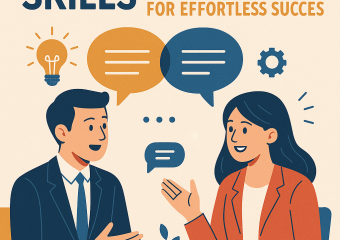Mastering the Art of Effective Communication
Effective communication is a crucial skill that plays a vital role in our personal and professional lives. It is the key to building strong relationships, resolving conflicts, and achieving success in various aspects of life. Mastering the art of effective communication can lead to better understanding, improved collaboration, and increased productivity. In this article, we will explore the importance of effective communication skills, understanding different communication styles, active listening techniques, nonverbal communication cues, overcoming barriers to effective communication, and tips for improving communication in professional settings.
Importance of Effective Communication Skills
Effective communication skills are essential for success in both personal and professional relationships. According to a study by the International Association of Business Communicators, 91% of employers rank communication skills as one of the most important qualities when hiring new employees. Good communication skills can help individuals express their thoughts and ideas clearly, listen actively to others, and build strong relationships based on trust and respect.
In the workplace, effective communication is crucial for fostering a positive work environment, enhancing teamwork, and increasing productivity. Poor communication can lead to misunderstandings, conflicts, and decreased morale among employees. By mastering the art of effective communication, individuals can improve their ability to convey information accurately, resolve conflicts peacefully, and collaborate effectively with colleagues.
Understanding Different Communication Styles
People have different communication styles based on their personality, cultural background, and upbringing. It is important to understand and adapt to these different styles to communicate effectively with others. According to research by the University of California, Davis, there are four main communication styles: assertive, aggressive, passive, and passive-aggressive.
Assertive communicators express their thoughts and feelings in a clear and respectful manner, while aggressive communicators tend to be confrontational and domineering. Passive communicators avoid conflict and may have difficulty expressing their needs and opinions. Passive-aggressive communicators may appear passive on the surface but express their anger or resentment in indirect ways.
By recognizing and understanding these different communication styles, individuals can adjust their own communication style to better connect with others and avoid misunderstandings. For example, a manager who is assertive in their communication style may need to adapt to a more passive approach when dealing with a passive employee to ensure effective communication.
Active Listening Techniques for Better Communication
Active listening is a crucial component of effective communication. It involves fully engaging with the speaker, paying attention to their words, and showing empathy and understanding. According to a study by the University of Minnesota, active listening can improve relationships, increase trust, and enhance problem-solving skills.
To practice active listening, individuals should focus on the speaker, maintain eye contact, nod their head to show understanding, and ask clarifying questions to ensure they have understood the message correctly. Reflecting back what the speaker has said can also demonstrate active listening and help clarify any misunderstandings.
Nonverbal Communication Cues to Pay Attention To
Nonverbal communication plays a significant role in effective communication. According to research by Albert Mehrabian, nonverbal cues such as body language, facial expressions, and tone of voice can account for up to 93% of the message conveyed in a conversation. It is important to pay attention to these nonverbal cues to better understand the speaker’s emotions and intentions.
For example, crossed arms and a furrowed brow may indicate defensiveness or disagreement, while open body language and a smile can signal openness and receptiveness. By being aware of these nonverbal cues, individuals can adjust their own body language and tone of voice to enhance their communication and build rapport with others.
Overcoming Barriers to Effective Communication
There are several common barriers to effective communication that can hinder the exchange of information and ideas. These barriers include language barriers, cultural differences, emotional barriers, and physical barriers. By identifying and addressing these barriers, individuals can improve their communication skills and build stronger relationships with others.
Language barriers can arise when individuals speak different languages or have limited proficiency in a common language. In such cases, using simple language, visual aids, and gestures can help bridge the communication gap. Cultural differences can also impact communication, as different cultures may have varying norms and expectations regarding communication styles and etiquette.
Emotional barriers such as stress, anxiety, or anger can affect one’s ability to communicate effectively. By managing emotions and practicing self-awareness, individuals can overcome these barriers and communicate more clearly and calmly. Physical barriers such as noise, distractions, or distance can also impede communication. By eliminating or minimizing these physical barriers, individuals can create a conducive environment for effective communication.
Tips for Improving Communication in Professional Settings
In professional settings, effective communication is essential for building strong relationships with colleagues, clients, and stakeholders. To improve communication in the workplace, individuals can follow these tips:
1. Be clear and concise in your communication: Avoid using jargon or technical language that may confuse others. Use simple and straightforward language to convey your message clearly.
2. Listen actively to others: Practice active listening techniques such as maintaining eye contact, nodding your head, and asking clarifying questions to show that you are engaged and interested in the conversation.
3. Be mindful of your nonverbal cues: Pay attention to your body language, facial expressions, and tone of voice to ensure that your nonverbal cues are aligned with your verbal message.
4. Seek feedback and clarification: If you are unsure about something or need more information, don’t hesitate to ask for clarification. Seeking feedback can help prevent misunderstandings and improve communication.
5. Practice empathy and understanding: Put yourself in the other person’s shoes and try to see things from their perspective. Showing empathy and understanding can help build trust and strengthen relationships.
6. Use technology wisely: In today’s digital age, technology plays a significant role in communication. Use email, video conferencing, and other digital tools effectively to communicate with colleagues and clients.
By following these tips and techniques, individuals can enhance their communication skills and become more effective communicators in professional settings. Mastering the art of effective communication takes practice and dedication, but the benefits of improved relationships, increased productivity, and enhanced collaboration make it a worthwhile endeavor. By understanding different communication styles, practicing active listening, paying attention to nonverbal cues, overcoming barriers, and following these tips, individuals can become more confident and successful communicators in all aspects of their lives.







